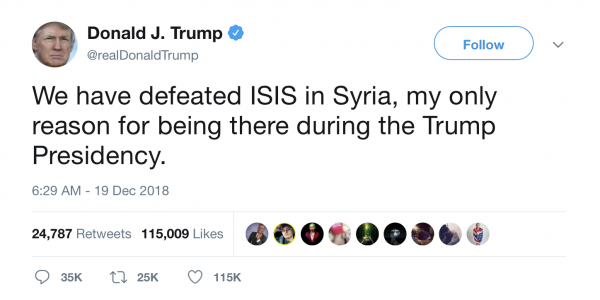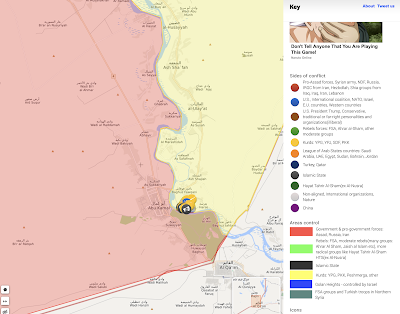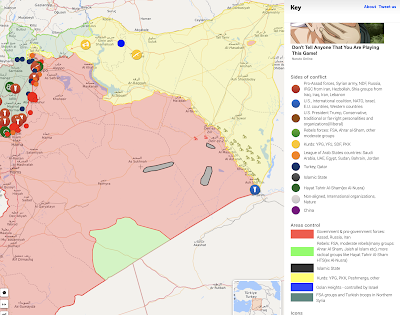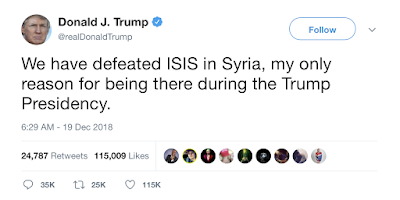
This article was last updated on April 16, 2022
Canada: ![]() Oye! Times readers Get FREE $30 to spend on Amazon, Walmart…
Oye! Times readers Get FREE $30 to spend on Amazon, Walmart…
USA: ![]() Oye! Times readers Get FREE $30 to spend on Amazon, Walmart…
Oye! Times readers Get FREE $30 to spend on Amazon, Walmart…
An article that, until recently, appeared in the online version of the February 2019 edition of France’s Revue Defense Nationale, takes a very critical look at how the United States forces in Syria executed their battle strategy against the remaining ISIS forces in Syria and the final success of the battle. Colonel Francois-Regis Legrier, a senior French officer who has been in charge of directed French artillery supporting Kurdish-led groups in Syria since October 2018. Colonel Legrier claims that the United States-led coalition fighting against ISIS in the Battle of Hajin (near Syria’s eastern border with Iraq) as shown on these maps (which show Syria to the north and east (pink and yellow) and Iraq to the south (grey) with the battle area located under the small blue bomb icon):
…had focussed on limiting risks to itself rather than decreasing the risks to civilians which has greatly increased the death toll among civilians and left the regions infrastructure severely damaged. Let’s look at a few details of Legrier’s commentary on the Battle of Hajin which took place between September 2018 and January 2019, the last battle to destroy the Islamic State which, at one point in time, controlled significant areas of both Iraq and Syria.
In the Battle of Hajin, there were approximately 2000 Islamist fighters, mainly foreigners, located in a thirty kilometre by 10 kilometre stretch along the Euphrates River in Syrian Arab-Kurdish territory. The area where military action took place is a V-shaped wedge of land located between the Euphrates River on the west and the Iraqi-Syrian border to the east. There are several thousand civilians present in the northern part of the Hajin pocket located in a mainly rural area. The Syrian regime and Iraqi militia control the West Bank of the Euphrates River and the area to the north of the city of Al-Qaim (in Iraq) is the firing position of the coalition forces. The southern border is controlled by the Katiba Hesbollah, a small relatively well equipped Iran-affiliated militia.
The author notes that the features of the ground fighting Battle of Hajin were very similar to battles of the First World War with a front line between fighters and with territorial gains reflecting violent attacks and counterattacks by each side through the massive use of artillery. The ground war was fought using a combination of saturation with explosive weapons and precision guided ammunition that was operational in all weather conditions. Islamic forces responded using rockets and mortars at rates of up to 100 per day. The coalition forces had supremacy in the air battle, using surveillance and intelligence to guide the use of its aerial bombardment strategy; over a six month period, several thousand bombs were dropped over a few dozen square kilometres, resulting in the destruction of the local infrastructure.
Colonel Legrier goes on to note that the United States subcontracted its duties to its proxies, most particularly the Syrian Democratic Forces who were delegated the responsibility of conducting ground operations, resulting in a loss of control of how the battle was fought. This led to higher levels of infrastructure destruction including hospitals, mosques, schools and residential area and a much higher human toll. Here is a quote from the Middle East Monitor about the human cost of the Battle of Hajin:
“Human rights groups have repeatedly criticised the US-led bombing campaign, which has resulted in the deaths of scores of civilians over the past six months; to date, some 700 civilians – over 250 of whom were children – have been killed, according to the Syrian Observatory for Human Rights. Thousands of civilians have fled the area, with the Al-Houl refugee camp in north-eastern Syria currently hosting over 39,000 people, mainly women and children.
In October, some 54 people – including 12 children – were killed in a single strike on a mosque in the town of Al-Susah, near the Iraqi border. The US alleged that the mosque was being used as a base by Daesh operatives; some 22 militants were also killed in the blast. Despite being hit during the weekly Friday congregational prayer, a popular time for civilians, the military claimed it targeted the mosque when only fighters were present.”
Here is what Legrier had to say about the results of the fighting:
“Has the enemy been reached in his morale and willingness to fight? Obviously no. He deployed an unshakable combativity to the end, taking advantage of periods of bad weather, preserving him from the air threat, to counter attack violently….”
The author notes that, once defeat became obvious, the Islamic fighters escaped to safe havens where they remain to continue the fight as an insurgency.
In his paper, Colonel Legrier made two very important observations:
1.) there is a limit to proxy warfare – ground troops must be engaged rather than just using Special Forces and the Air Force to actually win a war.
2.) there is a limit to the West’s techno-centric approach to warfare (i.e. the war halts while there is weather that prevent aerial attacks).
He also notes that the West has gained a short-term political advantage by avoiding significant losses during the Battle of Hajin and by retaining relatively positive public opinion about the coalition’s role in the Syrian war in general. That said, he clearly states that the American refusal to engage on the ground or by using attack helicopters suffuses that they have cast doubt on their intentions to finish the war against the Islamic State and leave Syria quickly.
Let’s look at what Legrier’s conclusions, using Google Translate to translate his commentary from French to English:
“Yes, the Battle of Hajin was won, at least on the ground but by refusing ground engagement, we unnecessarily prolonged the conflict and thus contributed to increasing the number of casualties in the population. We have massively destroyed the infrastructure and given the population a disgusting image of what may be a Western-style liberation leaving behind the seeds of an imminent resurgence of a new adversary. We have in no way won the war for want of a realistic and persevering policy and an adequate strategy. How many Hajins will it take to understand that we are on the wrong track?”
As the example of Iraq has shown us, conventional military forces find it extremely difficult and costly to win a war against a well-situated and well-armed insurgency. As well, the lengthy war in Iraq has shown us that it is very, very difficult to win the hearts and minds of civilians living in a war-torn area.
Despite Donald Trump’s mid-December proclamation that the war against the Islamic State was victorious as shown here:
…one of the key coalition players on the ground suggests strongly that such is not the case, that there is no future strategy for the region and that there is no lasting win.
Let’s close this posting with an update. Colonel Legrier’s public commentary and criticism of the events that took place during the Battle of Hajin resulted in his paper being removed from the online version of the Revue Defense Nationale and potential punishment from embarrassed French authorities who were about to announce the defeat of the Islamic State. I guess it doesn’t pay to criticize your allies in a war zone.
If you wish to read the paper in its entirety, you can use Google Translate on the documents found at these locations:
https://drive.google.com/file/d/1vX-7LX8pem2dpEEZkvrR0d5HQR3CEXW4/view
https://www.oyetimes.com/wp-content/uploads/2019/03/201920022028fevrier20-2081729.pdf
Click HERE to read more from this author.
You can publish this article on your website as long as you provide a link back to this page.




Be the first to comment